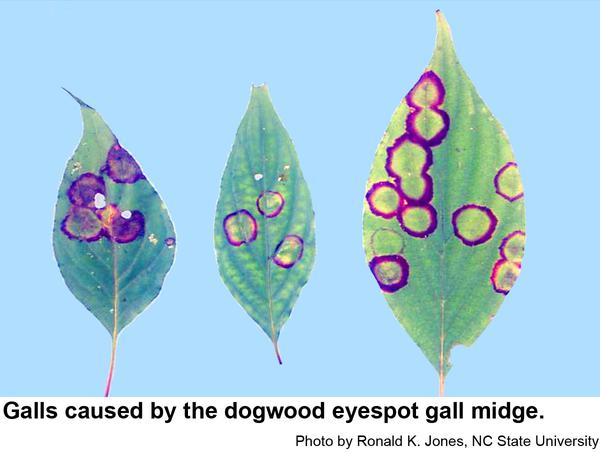Description and Biology
Dogwood eyespot galls are brightly colored red rings that appear on the surface of dogwood leaves. The leaf inside the ring is often noticeably pale. These colorful spots are caused by an ocellate gall midge, Parallelodiplosis subtruncata, in the family of gall midges. Although rarely seen, adult ocellate gall midges are tiny, mosquito-like flies that resemble other midge pests such as the maple eyespot gall midge. Dogwood eyespot gall midges occur throughout the range of flowering dogwood. This fly deposits eggs on the undersides of flowering dogwood leaves. This causes a response in the leaf resulting in gall formation. Secretions that female dogwood eyespot gall midges inject into the leaf cause a slight blister with red rings around the site of larval development. Ocellate gall midges emerge from the soil as an adult in early May and lay eggs in the underside of leaves. Teeny-weeny maggots develop within the leaf gall and grow to about 1/16 inch long. Maggots have been observed in the galls as late as September 21 in North Carolina. Eventually, maggots drop from the leaf to pupate in the soil. There is only one generation per year so these pupae remain in the soil until new adults emerge the following May.
Host Plant
Flowering dogwood seems to be the only host plant of the dogwood eyespot gall midge.
Residential Recommendations
In early spring, survey for leaves with red rings. These galls may appear similar to leaf spot symptoms caused by plant fungal diseases. To be sure, hold a suspected leaf gall up to a light source to look for a silhouette of the maggot in the center of the ring. Ocellate gall midges are unlikely to affect tree growth or health and are rarely abundant enough to cause real injury to the tree. However, they may cause some minor alarm for amateur horticulturists. Even if an insecticide is applied and the maggots are killed, the spots will not disappear. Parasitoids and parasitic flies usually keep dogwood eyespot gall midge populations at very low levels.
Other Resources
- Maple Eyespot Gall Midge. Steven Frank,S. and A. Dale. 2018 (revised). Entomology Insect Notes, NC State Extension Publications.
- The Plant-Feeding Gall Midges of North America. Raymond J. Gagné. 1989. Cornell University Press.
- Extension Plant Pathology Publications and Factsheets
- Horticultural Science Publications
- North Carolina Agricultural Chemicals Manual
For assistance with a specific problem, contact your local Cooperative Extension center.
This factsheet has not been peer reviewed.
Publication date: April 11, 2020
Reviewed/Revised: Jan. 15, 2025
Recommendations for the use of agricultural chemicals are included in this publication as a convenience to the reader. The use of brand names and any mention or listing of commercial products or services in this publication does not imply endorsement by NC State University or N.C. A&T State University nor discrimination against similar products or services not mentioned. Individuals who use agricultural chemicals are responsible for ensuring that the intended use complies with current regulations and conforms to the product label. Be sure to obtain current information about usage regulations and examine a current product label before applying any chemical. For assistance, contact your local N.C. Cooperative Extension county center.
N.C. Cooperative Extension prohibits discrimination and harassment regardless of age, color, disability, family and marital status, gender identity, national origin, political beliefs, race, religion, sex (including pregnancy), sexual orientation and veteran status.


